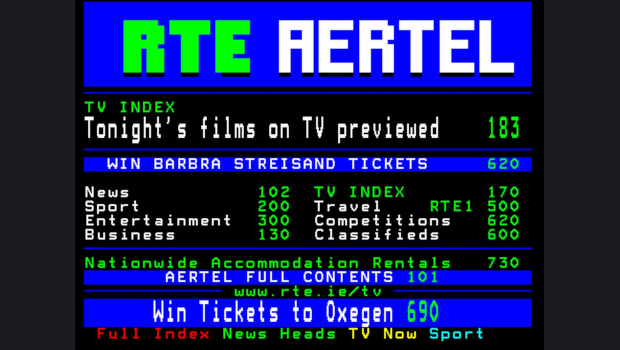
RTÉ cutbacks draw a line under dated innovations
October 2023 was the end of an era: it was the month when Aertel, RTÉ’s teletext service, came to a close. To be fair, it may come as a surprise to many readers that Aertel, which launched in 1987 and piggybacked digital information onto analogue television signals, was still around at all. After all, teletext has been basically a curiosity since the Internet arrived in our homes, but there is nevertheless something melancholy about its final demise.
Of course, the shuttering of its teletext service is hardly the most siginficant news to come out of RTÉ lately. On the day of writing, it was revealed that Ryan Tubridy, who was at the centre of the recent political storm about the broadcaster’s budget, is to move to British radio (with a show to be rebroadcast in Ireland). More importantly, however, RTÉ has also announced pay caps and a round of layoffs.
Director general Kevin Bakhurst has said that no-one will receive a salary higher than his €250,000 annual payout. This will mean some of the highest paid broadcasters will face wage cuts, but, in news that is actually sad, the broadcaster also revealed that some 400 jobs will go as part of the raft of cost-cutting measures.
It’s not all cuts, however. According to RTÉ’s New Direction plan, the straitened national public broadcaster will also develop “new digital products” and “new digital experiences”. This is not entirely surprising. After all, in August the broadcaster’s chairwoman Siún Ní Raghallaigh told an Oireachtas committee that RTÉ needed “increased investment” in digital services.
But precisely what does it mean? According to a news report, the plan is to “transform RTÉ Player to become one of the main ways people watch live programming, along with an extensive on-demand catalogue” and develop “new radio and news apps to be launched in 2025”.
The godawful RTÉ Player and, frankly not much better radio app, getting an overhaul is welcome news. It is hard to believe that RTÉ Player in particular, though, will see much love until the licence fee is replaced with something that online users also have to pay for, which is known to be RTÉ’s desired change to its funding regime.
What the “new digital experiences” will be, however, is unclear, at least to me. As per the report, enhanced access to RTÉ’s archives is straightforward enough, but “the addition of individual sign-in to video and audio products with investment in digital services” is a word salad that I cannot digest, despite having chewed on it for some time.
Radio days draw to a close
What about the other major digital service, though? What about radio? Well, what we do know is that “increased investment” in digital services does not mean any cash will be flowing in that particular direction.
In truth, digital radio has been a failure in Ireland, as it has in many European countries. Yes, Norway switched off its FM network in 2017 in favour of Digital Audio Broadcasting (DAB), and the UK has a significant number of digital radio stations, both public and private. In a lot of countries, however, no-one cares.
There are a number of reasons for this. First of all, the fact is that DAB is inferior to analogue FM (especially as so many stations broadcast in mono and using comically low bitrates). Worse still, it just came too late: few people buy new radios today, other than perhaps in their car, and the arrival of smartphone apps and devices like Amazon’s Echo and Google’s Nest made the costly act of blanketing a country in DAB signals pointless.
From a technical point of view, the competing Digital Radio Mondiale (DRM) standard may have stood a better chance as it would have given the long, medium and short wave bands a new lease of life, but it came even later than DAB so that’s that.
In addition, the commercial broadcasting sector in Ireland barely took any interest in DAB beyond a few trial services, leaving it to RTÉ to do the heavy lifting in terms of programming. But RTÉ is no BBC and has nothing like its budget, and so replicating the UK’s somewhat successful roll-out of DAB was never going to happen as RTÉ’s digital radio services are not really fully-fledged services, at least not in terms of what we expect from a major public broadcaster.
DAB broadcasts were shut down in 2021, but the digital stations continued to air on digital terrestrial television (DTT) as well as being streamed online.
RTÉ Pulse, 2XM, Chill, Junior, Gold and Radio 1 Extra are fine as far as they go, but only Gold is really close to what we understand as a radio station. Even then, it also has the feeling of being little more than a home away from home for Radio 1 DJs.
Obviously digital radio in Ireland was faced with a chicken and egg problem, even without the need to buy new radio receivers: not enough money was available to produce full-blown services, and the lack of programming kept listener numbers low.
However, by focussing on niche audiences; as RTÉ did, this could be seen as a virtue, at least after the closure of costly terrestrial broadcasting: listenership may have been small, but the stations, or streams really, were still serving audiences that otherwise would have gone unserved.
Not for much longer: Radio 1 Extra, 2XM, Pulse and RTÉjr Radio are all now set to close, sparing only Gold the accountancutioners’ axe. So that’s it: founded in 2008, most of RTÉ’s digital radio services are now to go the way of poor old Aertel.
It is not a loss that is likely to be met with mourning across the hills and the glens of the nation, but a loss it is. Digital radio, we hardly knew ye.





Subscribers 0
Fans 0
Followers 0
Followers